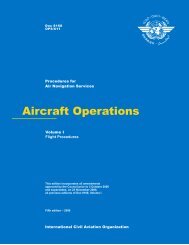Operation of Aircraft
Annex 6, Part I
Annex 6, Part I
- No tags were found...
You also want an ePaper? Increase the reach of your titles
YUMPU automatically turns print PDFs into web optimized ePapers that Google loves.
Annex 6 — <strong>Operation</strong> <strong>of</strong> <strong>Aircraft</strong><br />
4.3 Flight preparation<br />
4.3.1 A flight shall not be commenced until flight preparation<br />
forms have been completed certifying that the pilot-incommand<br />
is satisfied that:<br />
a) the aeroplane is airworthy;<br />
b) the instruments and equipment prescribed in Chapter 6,<br />
for the particular type <strong>of</strong> operation to be undertaken, are<br />
installed and are sufficient for the flight;<br />
c) a maintenance release as prescribed in 8.8 has been<br />
issued in respect <strong>of</strong> the aeroplane;<br />
d) the mass <strong>of</strong> the aeroplane and centre <strong>of</strong> gravity location<br />
are such that the flight can be conducted safely, taking<br />
into account the flight conditions expected;<br />
e) any load carried is properly distributed and safely<br />
secured;<br />
f) a check has been completed indicating that the operating<br />
limitations <strong>of</strong> Chapter 5 can be complied with for the<br />
flight to be undertaken; and<br />
g) the Standards <strong>of</strong> 4.3.3 relating to operational flight planning<br />
have been complied with.<br />
4.3.2 Completed flight preparation forms shall be kept by<br />
an operator for a period <strong>of</strong> three months.<br />
4.3.3 <strong>Operation</strong>al flight planning<br />
4.3.3.1 An operational flight plan shall be completed for<br />
every intended flight. The operational flight plan shall be<br />
approved and signed by the pilot-in-command and, where<br />
applicable, signed by the flight operations <strong>of</strong>ficer/flight dispatcher,<br />
and a copy shall be filed with the operator or a designated<br />
agent, or, if these procedures are not possible, it shall be<br />
left with the aerodrome authority or on record in a suitable<br />
place at the point <strong>of</strong> departure.<br />
Note.— The duties <strong>of</strong> a flight operations <strong>of</strong>ficer/flight<br />
dispatcher are contained in 4.6.<br />
4.3.3.2 The operations manual must describe the content<br />
and use <strong>of</strong> the operational flight plan.<br />
4.3.4 Alternate aerodromes<br />
4.3.4.1 Take-<strong>of</strong>f alternate aerodrome<br />
4.3.4.1.1 A take-<strong>of</strong>f alternate aerodrome shall be selected<br />
and specified in the operational flight plan if the weather conditions<br />
at the aerodrome <strong>of</strong> departure are at or below the applicable<br />
aerodrome operating minima or it would not be possible<br />
to return to the aerodrome <strong>of</strong> departure for other reasons.<br />
Part I<br />
4.3.4.1.2 The take-<strong>of</strong>f alternate aerodrome shall be located<br />
within the following distance from the aerodrome <strong>of</strong> departure:<br />
a) aeroplanes having two power-units. Not more than a<br />
distance equivalent to a flight time <strong>of</strong> one hour at the<br />
single-engine cruise speed; and<br />
b) aeroplanes having three or more power-units. Not more<br />
than a distance equivalent to a flight time <strong>of</strong> two hours<br />
at the one-engine inoperative cruise speed.<br />
4.3.4.1.3 For an aerodrome to be selected as a take-<strong>of</strong>f<br />
alternate the available information shall indicate that, at the<br />
estimated time <strong>of</strong> use, the conditions will be at or above the<br />
aerodrome operating minima for that operation.<br />
4.3.4.2 En-route alternate aerodromes<br />
En-route alternate aerodromes, required by 4.7 for extended<br />
range operations by aeroplanes with two turbine power-units,<br />
shall be selected and specified in the operational and air traffic<br />
services (ATS) flight plans.<br />
4.3.4.3 Destination alternate aerodromes<br />
For a flight to be conducted in accordance with the instrument<br />
flight rules, at least one destination alternate aerodrome shall<br />
be selected and specified in the operational and ATS flight<br />
plans, unless:<br />
a) the duration <strong>of</strong> the flight and the meteorological conditions<br />
prevailing are such that there is reasonable<br />
certainty that, at the estimated time <strong>of</strong> arrival at the aerodrome<br />
<strong>of</strong> intended landing, and for a reasonable period<br />
before and after such time, the approach and landing<br />
may be made under visual meteorological conditions; or<br />
b) the aerodrome <strong>of</strong> intended landing is isolated and there<br />
is no suitable destination alternate aerodrome.<br />
4.3.5 Weather conditions<br />
4.3.5.1 A flight to be conducted in accordance with the<br />
visual flight rules shall not be commenced unless current<br />
meteorological reports or a combination <strong>of</strong> current reports and<br />
forecasts indicate that the meteorological conditions along the<br />
route or that part <strong>of</strong> the route to be flown under the visual<br />
flight rules will, at the appropriate time, be such as to render<br />
compliance with these rules possible.<br />
4.3.5.2 A flight to be conducted in accordance with instrument<br />
flight rules shall not be commenced unless information is<br />
available which indicates that conditions at the aerodrome <strong>of</strong><br />
intended landing or, where a destination alternate is required,<br />
at least one destination alternate aerodrome will, at the estimated<br />
time <strong>of</strong> arrival, be at or above the aerodrome operating<br />
minima.<br />
1/11/01 23/11/06<br />
4-4<br />
No. 30












